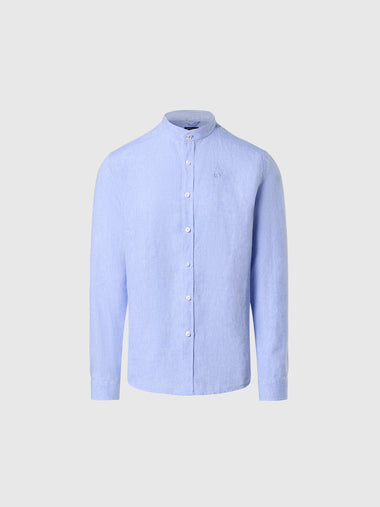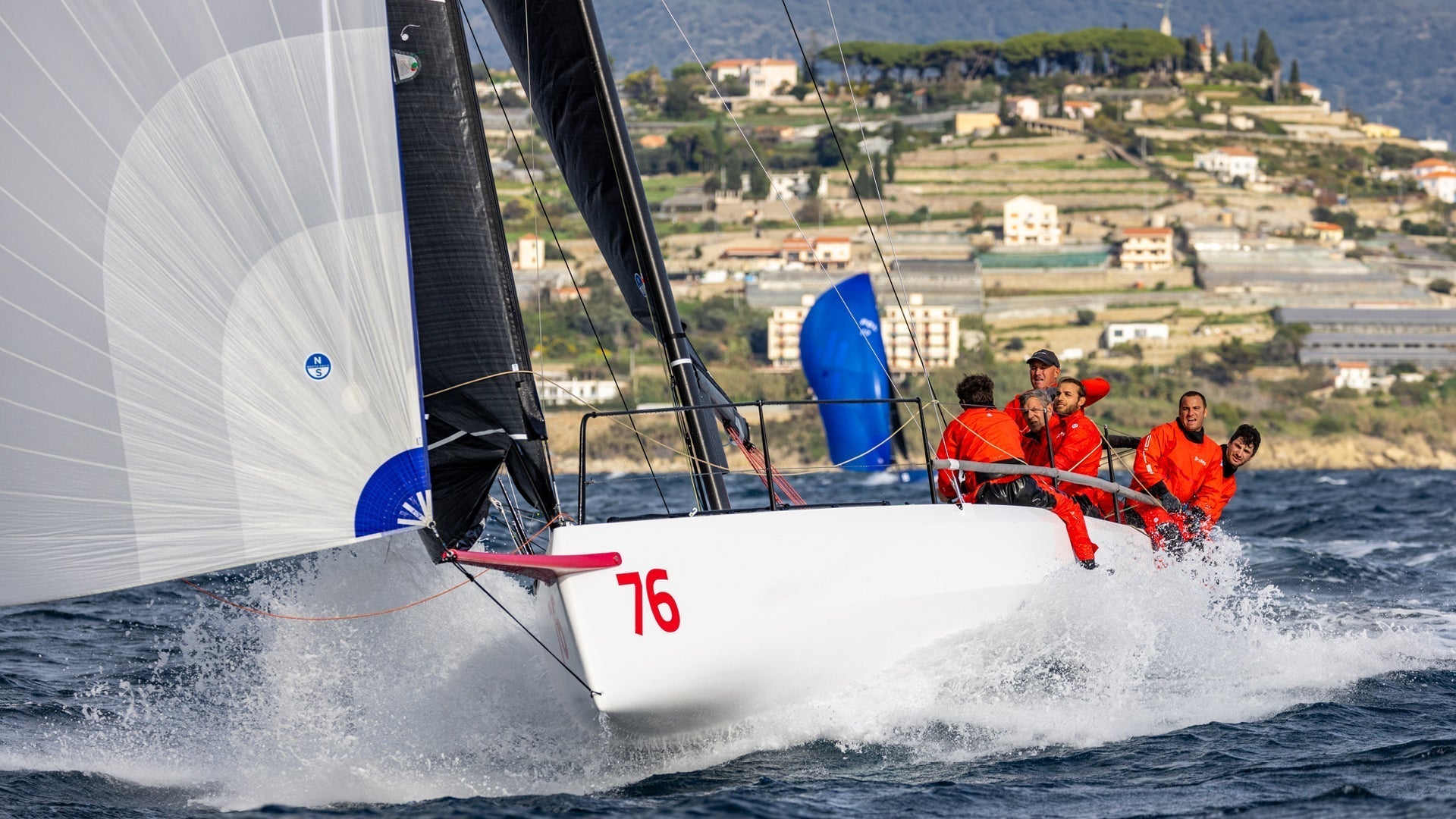RECENTLY LAUNCHED: MISS SHELL
Featuring a North Sails Engine-Above-Deck for a Y Yacht’s Y7
Miss Shell’s story starts with a Gulf Stream epiphany. “I was out on a boat one day with my buddies fishing off the coast of Florida. I always judge each day; if it was a good sailing day or not… and I looked at my buddies and I said, ‘You know what guys? I quit”’
“And they said, ‘You quit? You quit what?’
“I said, ‘This. I quit fishing, I quit powerboating, I quit it all… I’m going back to my roots; I’m going back to sailing. Guys, I’m not a fisherman, I’m a sailor.’’
“They didn’t really get it until I actually sold my boat and I bought the Y7, this beautiful 72-foot sailboat and they understood. It was literally that moment I just had to get back to sailing. I mean, that’s my happy place.”
The speaker is Eric Leiner, a sailor since he was ten years old, and a man whose enthusiasm would refresh even the most jaded devotee of the sport. “I took a long break from it. Coming up, I really enjoyed sailing with my father, but then when I got married and had kids, I stopped sailing because nobody in the family wanted to sail.” And just a year after his Gulf Stream moment, Eric Leiner was the owner of Miss Shell, a Y7 from Michael Schmidt Yachtbau (MSY), or Y Yachts. Schmidt is the storied boat-builder who founded, and then sold Hanse Yachts before moving onto this new project – launching the stable of the Y7, Y8, Y9 and YC to considerable acclaim.
It was the equally well-known American yacht designer, Bill Tripp, who was instrumental in Leiner’s choice of the Y7. Tripp designed the yacht and set up a demonstration. “I flew to Spain and sailed the boat in Palma,” said Leiner. “And at that moment, decided that was the right boat for me… The Y7 just has this classic, modern look to it, which I really liked… and of course, when I sailed it, I just thought it sailed beautifully. And from there, we negotiated a contract to build a new one with MSY yachts, up in Greifswald, Germany. And we executed that deal and a year later I was sailing….”

“Just the act of purchasing the boat created this incredible adventure,” he continued. “So here I am an American living in Palm Beach, Florida, and I’m having this boat built up on the Baltic. So… how do we get from the Baltic back to the United States?” Leiner decided to sail her back and was in the middle of the adventure when I spoke to him, touring Italy while Miss Shell was in Spain, being prepared for the Atlantic crossing. Over the summer they had sailed 4,000 miles from the Baltic, down the North Sea and the English Channel before heading south, “It was just a mad dash across the Bay of Biscay down the coast of Portugal, making a left into the Med and then just doing the entire coast of Spain, France, Italy, all summer long.
“I went to North just because of the reputation,” explained Leiner, “the manufacturing process of building the sails. I just thought that North Sails were a better sailmaker than anyone else. I wanted to build with the best… So, I selected North Sails and with Mike Toppa because he’s just a great representative of North Sails, and did a great job building our sails.”
Mike Toppa has been involved with North Sails since leaving college, starting as a spinnaker designer, then opening his own North loft in Fort Lauderdale and winning a couple of America’s Cups along the way. He’s now based out of the Newport, Rhode Island loft, focusing on superyacht, classic yacht and grand prix classes.
“It was the first time working within Y Yachts and the people there, which was a really nice experience,” said Toppa. “We did very limited sailing in Germany and it wasn’t until middle of September that I met up with Eric and Bill after the boat had sailed from Holland down to the Med; four thousand miles later, after a summer of delivery and cruising, we met up and did the Y Yachts Regatta in Ibiza, all three of us, which was great. So, it was fun to see the boat perform, see the sails perform and see how it all worked together.”
The sails onboard are 3Di Ocean. Mike Toppa explained the thinking, “3Di is how we make most of our sails. It’s a technology unique to North Sails, coupled with a unique manufacturing system that allows the flexibility needed to customize sails to precisely fit the specific requirements of any type of sailing.
In Eric’s case, we agreed that the Ocean line of sails was the best fit, because of the sailing he was going to do, which was very little racing and mostly worldwide cruising. So, longevity trumped all the other factors. When I got on the boat in Palma, after 4,000 plus miles of sailing, the sails looked like they just came out of the box. It was really remarkable. The whole idea was to make a super easy-to-use and very versatile sail inventory, and we were able to do that, allowing him to sail transatlantic, long distance cruising.”
“We didn’t produce a complex inventory,” said Leiner. “We did four sails. Obviously, we did a main, we did a roller furling jib, we did a storm jib and we did a gennaker… I said to Mike one day, I said, ‘Mike, I think maybe I want another set of sails to cross the Atlantic, so we preserve the sails that you built.’ He looked at me like I was crazy. He said, ‘Why would you need another set of sails? That’s what these sails are for. Cross the Atlantic with them, don’t worry about it…’ So, I’m like… that’s what we’re doing then.”

Glenn Cook, from the Marblehead loft, was the sail designer on the project. “The 3Di technology that we’re using is eliminating film in the sail, which is essentially just parasitic weight, so we’re left with just the structural material and the glues that hold it all together. And the resulting structure is just incredibly robust compared to anything else out there… The structural stability of the resulting sails is pretty incredible. I think cruising sailors can undervalue performance sails, not realizing that a sail that’s very low stretch and very stable and holds its shape across a wide wind range, is going to be a better cruising sail because you’re going to heel over less, you’re going to have to reef later. And generally, it forges the opportunity to have a more comfortable experience on the boat rather than being overpowered all the time.”
Once the big decisions on materials and inventory were made, a lot of detailed work began to ensure that the sails fit perfectly. “To do that, you have to do your homework and that meant getting the most recent updated plans from Bill and his design team, whenever there were deck layout changes or locations of hardware and things like that, you just have to know where all that is precisely,” said Toppa.
Glenn Cook picked up on his end of the process. “The main work that’s done with something like this is verifying mast bend from the spar builder… that’s obviously a very critical component to the success of the mainsail design…. We’ll get the structural characteristics of the rig and the rigging as well as a tuning guide on how the rig should be set up. And we essentially tune the rig within our software and then simulate the sailing of the boat to come up with a mast bend output. They’ll
There were a couple of novel details that had to be assimilated into the design for Miss Shell’s furling boom, accounting for a ramp fitted to the back of the mast which had the effect of increasing the mast bend. And the luff curve on the mainsail had to be balanced top to bottom so that as the sail furled down the rig, it would remain matched to the mast bend. The mainsail also has a square top, and allowance had to be made for this to flake onto the boom, as it was too stiff to roll.
All the attention to detail really paid dividends. “The project went as you always hope they do,” said Cook. “To me, it’s always fun that we can build all these parts separately. It’s a different spar builder, a different boat builder, a different sail maker, and just through the communication of the process, we can have everything come together and have a really good result at the end.”
“It was really fun for me because Eric was so enthusiastic,” added Mike Toppa. “It was really fun to feed off that and make sure that he had the best and all of his targets were met… And then of course working with Bill
And there’s no doubt that Eric Leiner is happy with the results. “Every inch of that 4,000 miles to me was spectacular… I’m just chomping at the bit to get back on board and do the next 5,000 miles that we’re about to do.” And would he recommend North Sails to other owners embarking on a project like this? Leiner didn’t miss a beat. “Hundred percent, yes, of course.”



















